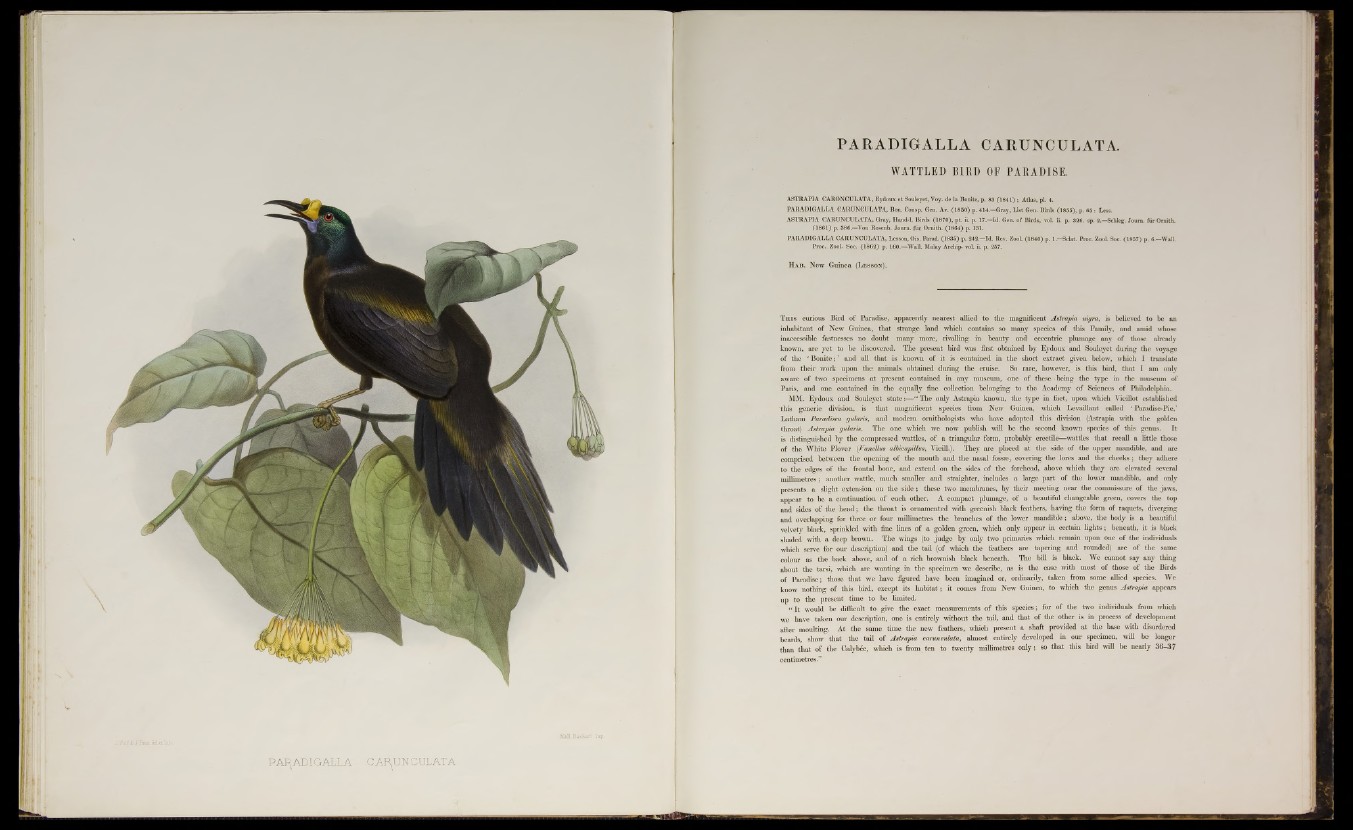
PARADIGALLA CAFy INC! .'LATA
PARADIGALLA CARUNCULATA.
WATTLED BIRD OF PARADISE.
ASTRAPIA CARONCULATA, Eydoux et Souleyet, Voy. de la Bonite, p. 83 (1841) ; Atlas, pi. 4.
PARADIGALLA CARUNCULATA, Bon. Consp. Gen. Av. (1 860) p. 414.—Gray, List Gen. Birds (1866), p. 66 : Less.
ASTRAPIA CARUNCULATA, Gray, Hand-1. Birds (1 870), pt. ii. p. 17.;—Id. Gen. o f Birds, vol. ii. p. 326. sp. 2.—Schleg. Journ. fur Ornith.
(1 8 6 1 ) p. 386.—Von Rosenb. Journ. fur Omith. (1 864) p. 131.
PARADIGALLA CARUNCULATA, Lesson, Ois. Parad. (1 836) p. 242.—Id. Rev. Zool. (1 840) p. 1.—Sclat. Proc. Zool. Soc. (1 857) p. 6.—Wall.
Proc.. Zool. Soc. (1 862) p. 160.—Wall. Malay Archip* vol. ii; p. 257.
H a b . New Guinea (L e s s o n )^
T h i s curious Bird of Paradise, apparently nearest allied to the magnificent Astrapia nigra, is believed to be an
inhabitant of New Guinea, that strange land which contains so many species of this Family, and amid whose
inaccessible fastnesses no doubt many more, rivalling in beauty and eccentric plumage any of those already
known, are yet to be discovered. The present bird was first obtained by Eydoux and Souleyet during the voyage
of the ‘ Bonite; ’ and all that is known of it is contained in the short extract given below, which I translate
from their work upon the animals obtained during the cruise. So rare, however, is this bird, that I am only
aware of two specimens at present contained in any museum, one of these being the type in the museum of
Paris, and one contained in the equally fine collection belonging to the Academy of Sciences of Philadelphia.
MM. Eydoux and Souleyet state:—“ The only Astrapia known, the type in fact, upon which Vieillot established
‘this generic division, is that magnificent species from New Guinea, which Levaillant called ‘ Paradise-Pie,’
Latham Paradisea gularis, and modern ornithologists who have adopted this division (Astrapia with the golden
throat) Astrapia gularis. The one which we now publish will be the second known species of this genus. It
is distinguished by the compressed wattles, of a triangular form, probably erectile—wattles that recall a little those
of the White Plover (Vanellus albicapillus, Vieill.). They are placed at the side of the upper mandible, and are
comprised between the opening of the mouth and the nasal fossae, covering the lores and the cheeks; they adhere
to the edges of the frontal bone, and extend on the sides of the forehead, above which they are elevated several
millimetres; another wattle, much smaller and straighter, includes a large part of the lower mandible, and only
presents a slight extension on the side; these two membranes, by their meeting near the commissure of the jaws,
appear to be a continuation of each other. A compact plumage, of a beautiful changeable green, covers the top
and sides of the head; the throat is ornamented with greenish black feathers, having the form of raquets, diverging
and overlapping for three or four millimetres the branches of the lower mandible; above, the body is a beautiful
velvety black, sprinkled with fine lines of a golden green, which only appear in certain lights; beneath, it is black
shaded with a deep brown. The wings (to judge by only two primaries which remain upon one of the individuals
which serve for our description) and the tail (of which the feathers are tapering and rounded) are of the same
colour as the back above, and of a rich brownish black beneath. The bill is black. We cannot say any thing
about the tarsi, which are wanting in the specimen we describe, as is the case with most of those of the Birds
o f Paradise; those that we have figured have been imagined or, ordinarily, taken from some allied species. We
know nothing of this bird, except its habitat; it comes from New Guinea, to which the genus Astrapia appears
up to the present time to be limited.
“ It would be difficult to give the exact measurements of this species; for of the two individuals from which
we have taken our description, one is entirely without the tail, and that of the other is in process of development
after moulting. At the same time the new feathers, which present a shaft provided at the base with disordered
beards, show that the tail of Astrapia caruneulata, almost entirely developed in our specimen, will be longer
than that o f the Calyb^e, which is from ten to twenty millimetres only; so that this bird will be nearly 36—37
centimetres.”